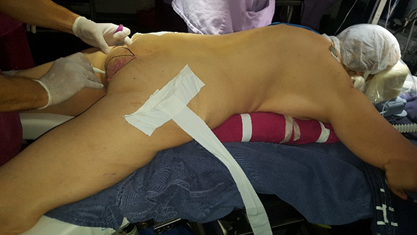Journal of
eISSN: 2373-633X


Case Report Volume 15 Issue 2
1Assistant Professor at Hospital de Clínicas, Uruguay
2Resident at Hospital de Clínicas, Uruguay
3Add. Prof, Professor, Director of the Academic Surgical Unit “A” Hospital de Clínicas, Uruguay
Correspondence: Ulysses Parada, Assistant Professor, Academic Surgical Unit “A” Hospital de Clínicas, Montevideo, Uruguay
Received: April 16, 2024 | Published: May 6, 2024
Citation: Parada U, Guarneri C, Ramirez L, et al. V-Y adipose skin flap for the treatment of extensive perianal condylomatosis. J Cancer Prev Curr Res. 2024;15(2):35-38. DOI: 10.15406/jcpcr.2024.15.00546
Introduction: Perianal condylomatosis is a common disease that can involve large areas of skin and anal mucosa, making treatment complex. From a surgical point of view, there are several therapeutic options ranging from primary closure to myocutaneous flap rotation.
Aim: Describe the surgical technical details of the VY flap based on the report of 4 clinical cases with extensive perianal condylomatosis as part of the comprehensive treatment of the disease.
Methods: Retrospective, descriptive study of patients operated on at Hospital de Clínicas (UDELAR) and CASMU mutual society. Analysis was performed on 4 patients who presented with extensive perianal condylomatosis of approximately 5-6 cm radius of the anal margin in the 5-year time period.
Result: In all 4 cases, surgical treatment was performed by rotating the skin flap in VY of the disease; in 1 of the cases, complementary therapy with cryotherapy was also performed. We had no cases of stenosis or flap necrosis.
Conclusion: Surgery is a fundamental arm in the treatment of perineal condylomatosis. Reconstruction using a VY adipose skin flap is a possible alternative.
The use of several complementary therapeutic modalities is essential in the management of this pathology.
Keywords: extensive perianal condylomatosis, surgery, VY flap
Perianal condylomatosis is one of the most common sexually transmitted diseases currently caused by the human papillomavirus (HPV).1,2 Although various treatments have been proposed (imiquimod, electrofulguration, laser cryotherapy, etc.), none alone offers complete resolution of the disease. We focus on combining different therapeutic options in order to improve results.3,4 In larger lesions, surgery becomes more relevant.5 When resections of large areas of the perineal area are required, reconstructive techniques are used, one of the most widespread is the creation of a VY adipose skin flap.
From a surgical point of view, there are several therapeutic options ranging from primary closure to myocutaneous flap rotation. The objective of surgery is to completely or partially resect the disease, restore the integrity of the area, not affect functionality (anal canal stenosis) and be as aesthetic as possible. In addition to the above, surgery alone is often not enough and requires the combination of different therapeutic modalities simultaneously or metachronously to provide better results.
Describe the surgical technical details of the VY flap based on the report of 4 clinical cases with extensive perianal condylomatosis as part of the comprehensive treatment of the disease.
Retrospective, descriptive study of patients operated on at Hospital de Clínicas (UDELAR) and mutual benefit CASMU in Montevideo Uruguay. The analysis was performed on 4 patients who presented with extensive perianal condylomatosis of approximately 5-6 cm radius of the anal margin in the 5-year time period (Figure 1).
These are patients between 35 and 60 years old, 2 female and 2 male. The 4 VDRL negative patients and one HIV positive patient were treated with antiretroviral therapy. One patient has high blood pressure and had a kidney transplant in 2015. The rest of the patients have no other history of note. Clinically they do not present pruritus, pain, or bleeding. Extensive condylomatosis is seen in the perianal region that does not involve the vagina or scrotum and does not appear to involve the anal canal in any of the cases presented.
The patients came for consultation for evaluation for general surgery and different medical specialties (dermatology, gastroenterology). They were evaluated by performing a biopsy in several quadrants without elements of malignancy. Colonic preparation was performed with antibiotic prophylaxis 30 minutes before surgery using ampicillin and sulbactam and an enema the night before. No anterograde mechanical preparations were used, nor were prior dietary measures performed.
General anesthesia is used in all procedures. Correct fixation of the orotracheal tube is important to avoid accidental extubation during transition to the prone position. At this moment the anesthesiologist must secure the airway and direct the patient's rotation maneuver in a delicate and synchronized manner. Once recumbency is achieved, a horseshoe-shaped pad will be placed to fix the head and support the cervical spine.
The position chosen by the author group is in a jackknife position with separated lower limbs as shown in Figure 2.

Figure 2 Posición del paciente en navaja se utiliza esparadrapos para mejorar la exposición de la zona perianal.
For better exposure of the affected area, tape is used to separate both buttocks. A rectal examination was performed under anesthesia and the area was marked with a demographic pencil, covering the resection area, maintaining a distance from the anal margin of approximately 3 mm at least from the dentate line to reduce the probability of anal stenosis. Regarding the external edge of the area to be resected, it is a matter of including the entire lesion without prejudice to which, when there is a punctate or small lesion (Figure 3, 4), to avoid resection of healthy skin that makes it difficult to cover the skin defect, one can resort. to complementary techniques such as cryoablation. In this way, relying on techniques that are not mutually exclusive, but on the contrary complementary, we avoid large resections that make closure more complex and difficult.
In addition to a rectal examination, once the patient is in position and under anesthesia, we always perform an anoscopy to evaluate the anal canal and rectum in order to identify injuries that have gone unnoticed (Figure 5).
The resection of the lesion must respect the anal margin and its mucosa, including the affected region as shown in Figure 6.
The specimen is sent for anatomopathological study, of which we are especially interested in whether there are malignant transformation zones and the existence of disease-free margins (Figure 7).

Figure 7 Pieza para estudio anatomopatológico. Interesa presencia de malignidad y márgenes de resección.
The flap must include part of the subcutaneous cell to allow mobility toward the midline (Figure 8). The union in the midline and mucosa of the anal canal is made by suturing with vicryl 3-0 points separated. (Figure 9) The midline and lateral sectors are closed with separate PDS 3-0 stitches (Figure 10).
Drain placement was not necessary in any of the patients. The implementation of protective ostomies has its argument in flap care to reduce the incidence of infection, but the morbidity of the procedure and especially its subsequent closure must be considered. No ostomies were performed, nor was the placement of drains necessary in any of the patients.
The results of the pathological anatomy of 3 of the patients did not show malignancy with lesion-free edges. In one of the patients, the pathology report showed a condyloma acuminatum with an H-SIL lesion. Internal and external lateral margin pass through injury. Deep injury-free margin.
The therapy was complemented with 2 cycles of cryotherapy by the dermatology team. Figure 11 shows the appearance 2 months after surgery and cryotherapy. A follow-up was performed after one year of evolution in the 4 patients, and no elements of loco regional recurrence were identified.
The management of patients with extensive perianal condylomatosis is challenging and can generate additional complications, therefore it benefits from a multidisciplinary and experienced team.6 The difficulties that arise in the treatment of these patients are, on the one hand, A- the lesion itself, which, being extensive, requires extensive resection, ergo a great solution of continuity, B- the topography close to the anal margin and often compromised. It can bring about stenotic complications and finally C-repair with the defect without tension and well vascularized. To choose a surgical technique we must keep these 3 factors mentioned above in mind. In this study, we propose the VY flap technique as feasible to be used in extensive perianal resections that could not be closed by a simple closure or so large that it requires rotation of the myocutaneous flap.7–9
Its advantages are to resect the lesion and can be used as a sole or complementary treatment. In the case of isolated, more distant lesions that require the resection of large sectors of healthy skin, ablative procedures can be used in order to reduce the continuity gap. It is a simple technique; skin flaps do not require too much mobilization, just a couple of centimeters, or rotation, which reduces the probability of ischemia. Pursuing aesthetic results as much as possible.
Surgery is a fundamental arm in the treatment of perineal condylomatosis. In large affected areas requiring extensive resections where edge-to-edge closure is not possible, reconstruction using a V-Y adipose skin flap is a possible alternative. The use of several complementary therapeutic modalities is essential in the management of this pathology.
None.
The authors declare that there are no conflicts of interest.

©2024 Parada, et al. This is an open access article distributed under the terms of the, which permits unrestricted use, distribution, and build upon your work non-commercially.
 Month of July is here, which is commonly known for the World Sarcoma month, the major aim of this program is to Educate people on early signs of Sarcoma and its diagnosis. To be part of this, we are doing our best to spread its awareness by accepting articles on this topic and grab best discount of 30% for your submissions to our Journal of Cancer Prevention & Current Research (JCPCR).
Month of July is here, which is commonly known for the World Sarcoma month, the major aim of this program is to Educate people on early signs of Sarcoma and its diagnosis. To be part of this, we are doing our best to spread its awareness by accepting articles on this topic and grab best discount of 30% for your submissions to our Journal of Cancer Prevention & Current Research (JCPCR).